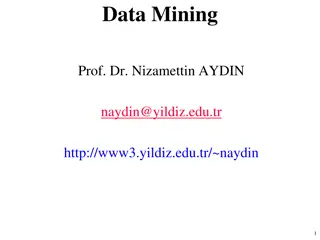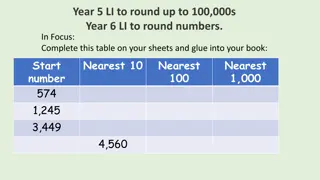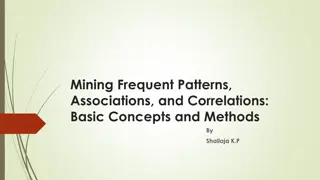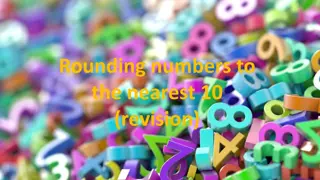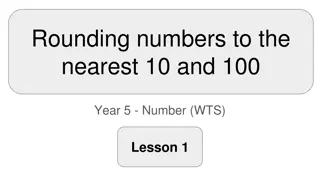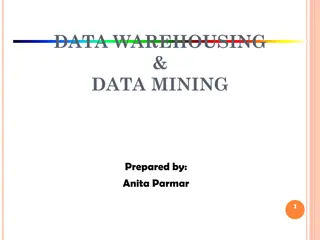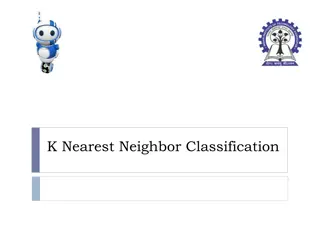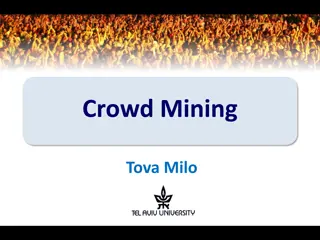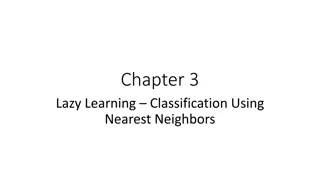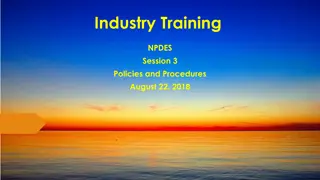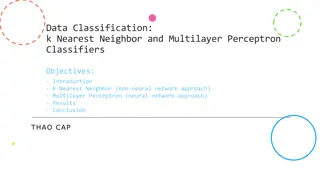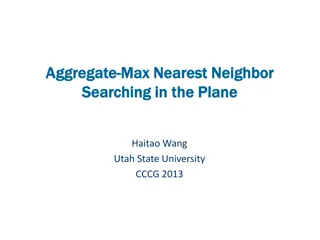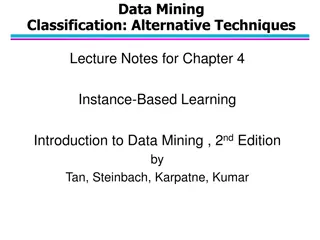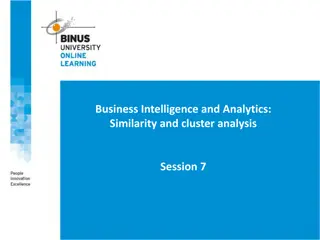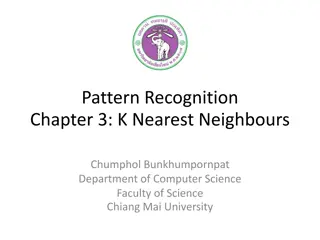Understanding Nearest Neighbor Classification in Data Mining
Classification methods in data mining, like k-nearest neighbor, Naive Bayes, Logistic Regression, and Support Vector Machines, rely on analyzing stored cases to predict the class label of unseen instances. Nearest Neighbor Classifiers use the concept of proximity to categorize data points, making decisions based on the closest neighboring records. By computing distances and selecting k nearest neighbors, these classifiers are able to classify unknown instances effectively.
- Nearest Neighbor Classification
- Data Mining
- Instance-Based Classifiers
- Classification Methods
- Proximity Analysis
Download Presentation

Please find below an Image/Link to download the presentation.
The content on the website is provided AS IS for your information and personal use only. It may not be sold, licensed, or shared on other websites without obtaining consent from the author. Download presentation by click this link. If you encounter any issues during the download, it is possible that the publisher has removed the file from their server.
E N D
Presentation Transcript
DATA MINING LECTURE 10 Classification k-nearest neighbor classifier Na ve Bayes Logistic Regression Support Vector Machines
NEAREST NEIGHBOR CLASSIFICATION
Instance-Based Classifiers Set of Stored Cases Store the training records Use training records to predict the class label of unseen cases Atr1 AtrN Class A ... B B Unseen Case C Atr1 AtrN ... A C B
Instance Based Classifiers Examples: Rote-learner Memorizes entire training data and performs classification only if attributes of record match one of the training examples exactly Nearest neighbor Uses k closest points (nearest neighbors) for performing classification
Nearest Neighbor Classifiers Basic idea: If it walks like a duck, quacks like a duck, then it s probably a duck Compute Distance Test Record Training Records Choose k of the nearest records
Nearest-Neighbor Classifiers Unknown record Requires three things The set of stored records Distance Metric to compute distance between records The value of k, the number of nearest neighbors to retrieve To classify an unknown record: Compute distance to other training records Identify k nearest neighbors Use class labels of nearest neighbors to determine the class label of unknown record (e.g., by taking majority vote)
Definition of Nearest Neighbor X X X (a) 1-nearest neighbor (b) 2-nearest neighbor (c) 3-nearest neighbor K-nearest neighbors of a record x are data points that have the k smallest distance to x
1 nearest-neighbor Voronoi Diagram defines the classification boundary The area takes the class of the green point
Nearest Neighbor Classification Compute distance between two points: Euclidean distance = ( , ) ( 2) d p q p q i i i Determine the class from nearest neighbor list take the majority vote of class labels among the k- nearest neighbors Weigh the vote according to distance weight factor, w = 1/d2
Nearest Neighbor Classification Choosing the value of k: If k is too small, sensitive to noise points If k is too large, neighborhood may include points from other classes X
Nearest Neighbor Classification Scaling issues Attributes may have to be scaled to prevent distance measures from being dominated by one of the attributes Example: height of a person may vary from 1.5m to 1.8m weight of a person may vary from 90lb to 300lb income of a person may vary from $10K to $1M
Nearest Neighbor Classification Problem with Euclidean measure: High dimensional data curse of dimensionality Can produce counter-intuitive results 1 1 1 1 1 1 1 1 1 1 1 0 1 0 0 0 0 0 0 0 0 0 0 0 vs 0 1 1 1 1 1 1 1 1 1 1 1 0 0 0 0 0 0 0 0 0 0 0 1 d = 1.4142 d = 1.4142 Solution: Normalize the vectors to unit length
Nearest neighbor Classification k-NN classifiers are lazy learners It does not build models explicitly Unlike eager learners such as decision tree induction and rule-based systems Classifying unknown records are relatively expensive Na ve algorithm: O(n) Need for structures to retrieve nearest neighbors fast. The Nearest Neighbor Search problem.
Nearest Neighbor Search Two-dimensional kd-trees A data structure for answering nearest neighbor queries in R2 kd-tree construction algorithm Select the x or y dimension (alternating between the two) Partition the space into two with a line passing from the median point Repeat recursively in the two partitions as long as there are enough points
Nearest Neighbor Search 2-dimensional kd-trees
Nearest Neighbor Search 2-dimensional kd-trees
Nearest Neighbor Search 2-dimensional kd-trees
Nearest Neighbor Search 2-dimensional kd-trees
Nearest Neighbor Search 2-dimensional kd-trees
Nearest Neighbor Search 2-dimensional kd-trees
Nearest Neighbor Search 2-dimensional kd-trees region(u) all the black points in the subtree of u
Nearest Neighbor Search 2-dimensional kd-trees A binary tree: Size O(n) Depth O(logn) Construction time O(nlogn) Query time: worst case O(n), but for many cases O(logn) Generalizes to d dimensions Example of Binary Space Partitioning
SUPPORT VECTOR MACHINES
Support Vector Machines Find a linear hyperplane (decision boundary) that will separate the data
Support Vector Machines B1 One Possible Solution
Support Vector Machines B2 Another possible solution
Support Vector Machines B2 Other possible solutions
Support Vector Machines B1 B2 Which one is better? B1 or B2? How do you define better?
Support Vector Machines B1 B2 b21 b22 margin b11 b12 Find hyperplane maximizes the margin => B1 is better than B2
Support Vector Machines B1 + = 0 w x b + = + 1 w x b + = 1 w x b b11 b12 + 2 1 if w x b 1 x = Margin = ( ) f w || || + 1 if w x b 1
Support Vector Machines 2 = We want to maximize: Margin w 2|| || 2 || || w = ( ) L w Which is equivalent to minimizing: 2 But subjected to the following constraints: ? ??+ ? 1 if ??= 1 ? ??+ ? 1 if ??= 1 This is a constrained optimization problem Numerical approaches to solve it (e.g., quadratic programming)
Support Vector Machines What if the problem is not linearly separable?
Support Vector Machines What if the problem is not linearly separable? ?? ?
Support Vector Machines What if the problem is not linearly separable? Introduce slack variables Need to minimize: || || ) ( 2 N w 2 = i = + k L w C i 1 Subject to: ? ??+ ? 1 ?? if ??= 1 ? ??+ ? 1 + ??if ??= 1
Nonlinear Support Vector Machines What if decision boundary is not linear?
Nonlinear Support Vector Machines Transform data into higher dimensional space
Classification via regression Instead of predicting the class of an record we want to predict the probability of the class given the record The problem of predicting continuous values is called regression problem General approach: find a continuous function that models the continuous points.
Example: Linear regression Given a dataset of the form (?1,?1) , ,(??,??) find a linear function that given the vector ?? predicts the ?? value as ?? Find a vector of weights ? that minimizes the sum of square errors = ???? ?? 2 ?? ? Several techniques for solving the problem.
Classification via regression Assume a linear classification boundary For the positive class the bigger the value of ? ?, the further the point is from the classification boundary, the higher our certainty for the membership to the positive class Define ?(?+|?) as an increasing function of ? ? ? ? > 0 ? ? = 0 For the negative class the smaller the value of ? ?, the further the point is from the classification boundary, the higher our certainty for the membership to the negative class Define ?(? |?) as a decreasing function of ? ? ? ? < 0
Logistic Regression The logistic function 1 ? ? = 1 ? ? 1 ? ?+? = 1 ? ? ? ? ? ? 1 ? ? ? ? ? ? = log? ?+? ? ? ? = ? ? Logistic Regression: Find the vector ? that maximizes the probability of the observed data
Logistic Regression Produces a probability estimate for the class membership which is often very useful. The weights can be useful for understanding the feature importance. Works for relatively large datasets Fast to apply.
Bayes Classifier A probabilistic framework for solving classification problems A, C random variables Joint probability: Pr(A=a,C=c) Conditional probability: Pr(C=c | A=a) Relationship between joint and conditional probability distributions Pr( ) | Pr( ) , Pr( A C A C = = ) Pr( | ) Pr( ) A A C C ( | ) ( ) P A C P C Bayes Theorem: = ( | ) P C A ( ) P A
Example of Bayes Theorem Given: A doctor knows that meningitis causes stiff neck 50% of the time Prior probability of any patient having meningitis is 1/50,000 Prior probability of any patient having stiff neck is 1/20 If a patient has stiff neck, what s the probability he/she has meningitis? / 1 ( | ) ( ) 5 . 0 50000 P S M P M = = = ( | ) 0002 . 0 P M S ( ) / 1 20 P S
Bayesian Classifiers Consider each attribute and class label as random variables Given a record with attributes (A1, A2, ,An) Goal is to predict class C Specifically, we want to find the value of C that maximizes P(C| A1, A2, ,An ) Can we estimate P(C| A1, A2, ,An ) directly from data?
Bayesian Classifiers Approach: compute the posterior probability P(C | A1, A2, , An) for all values of C using the Bayes theorem ( | ) ( ) P A A A C P C = ( | ) P C A A A 1 P 2 n ( ) A A A 1 2 n 1 2 n Choose value of C that maximizes P(C | A1, A2, , An) Equivalent to choosing value of C that maximizes P(A1, A2, , An|C) P(C) How to estimate P(A1, A2, , An | C )?
Nave Bayes Classifier Assume independence among attributes Ai when class is given: ?(?1,?2, ,??|??) = ?(?1|??) ?(?2?? ?(??|??) We can estimate P(Ai| Cj) for all Ai and Cj. New point X is classified to Cj if ? ??? = ? ?? ??(??|??) is maximal.
How to Estimate Probabilities from Data? categorical categorical continuous class Class: P(C) = Nc/N e.g., P(No) = 7/10, P(Yes) = 3/10 Tid Refund Marital Taxable Income Evade Status 1 Yes Single 125K No For discrete attributes: P(Ai | Ck) = |Aik|/ Nc where |Aik| is number of instances having attribute Ai and belongs to class Ck Examples: 2 No Married 100K No 3 No Single 70K No k 4 Yes Married 120K No 5 No Divorced 95K Yes 6 No Married 60K No 7 Yes Divorced 220K No 8 No Single 85K Yes 9 No Married 75K No P(Status=Married|No) = 4/7 P(Refund=Yes|Yes)=0 10 No Single 90K Yes 10
How to Estimate Probabilities from Data? For continuous attributes: Discretize the range into bins one ordinal attribute per bin violates independence assumption Two-way split: (A < v) or (A > v) choose only one of the two splits as new attribute Probability density estimation: Assume attribute follows a normal distribution Use data to estimate parameters of distribution (e.g., mean and standard deviation) Once probability distribution is known, can use it to estimate the conditional probability P(Ai|c)




